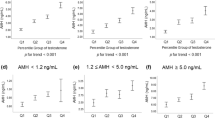Abstract
It has recently been found by various authors that despite a normal serum concentration of oestradiol (E2), the percentage of non-protein-bound or free E2 is abnormally high in breast cancer patients. Since it is the free E2 which is considered to be biologically active, confirmation of this finding would be most relevant to the pathogenesis of breast cancer. Using Hammond's centrifugal ultrafiltration dialysis method we have measured free E2 in heparinized plasma from 68 premenopausal women (a) at high familial risk of breast cancer (n = 18), (b) with benign breast disease (n = 17), (c) cured of T1N0M0 breast cancer at least 6 months previously (n = 17) and (d) normal controls matched for age, parity and Quetelet index (n = 16). Sex hormone binding globulin (SHBG) was measured as [3H]-dihydrotestosterone binding capacity. Free E2 and SHBG were also measured in the serum of (e) postmenopausal patients having breast cancer (n = 38) and (f) matched control cancer patients (n = 67). We confirmed a very good inverse correlation between log free E2 per cent and log SHBG (P less than 0.0001). The regression lines for groups (a)-(d) were not statistically different. The regression lines for groups (e) and (f) were identical and ran nearly parallel to those for groups (a)-(d) though somewhat lower. This small difference may be ascribed to menopausal status. Therefore, we found no difference in free E2 percentage, calculated free E2 concentration or SHBG between premenopausal women at risk, women with benign breast disease, patients cured for early breast cancer or having breast cancer and matched controls. However, postmenopausal breast cancer patients had a significantly higher total serum E2 concentration and, by consequence a higher calculated free E2 concentration compared to the carefully matched control group.
This is a preview of subscription content, access via your institution
Access options
Subscribe to this journal
Receive 24 print issues and online access
$259.00 per year
only $10.79 per issue
Buy this article
- Purchase on Springer Link
- Instant access to full article PDF
Prices may be subject to local taxes which are calculated during checkout
Similar content being viewed by others
Rights and permissions
About this article
Cite this article
Bruning, P., Bonfrèr, J. & Hart, A. Non-protein bound oestradiol, sex hormone binding globulin, breast cancer and breast cancer risk. Br J Cancer 51, 479–484 (1985). https://doi.org/10.1038/bjc.1985.69
Issue Date:
DOI: https://doi.org/10.1038/bjc.1985.69
This article is cited by
-
Changes in body weight and the risk of breast cancer in BRCA1 and BRCA2mutation carriers
Breast Cancer Research (2005)
-
Sex Hormone-Binding Globulin: Not only a transport protein. What news is around the corner?
Journal of Endocrinological Investigation (1999)
-
The relation of reported alcohol ingestion to plasma levels of estrogens and androgens in premenopausal women (Maryland, United States)
Cancer Causes & Control (1994)
-
The international variation in breast cancer rates: An epidemiological assessment
Breast Cancer Research and Treatment (1991)
-
Serum hormone levels in pre-menopausal Chinese women in Shanghai and white women in Los Angeles: results from two breast cancer case-control studies
Cancer Causes and Control (1990)


